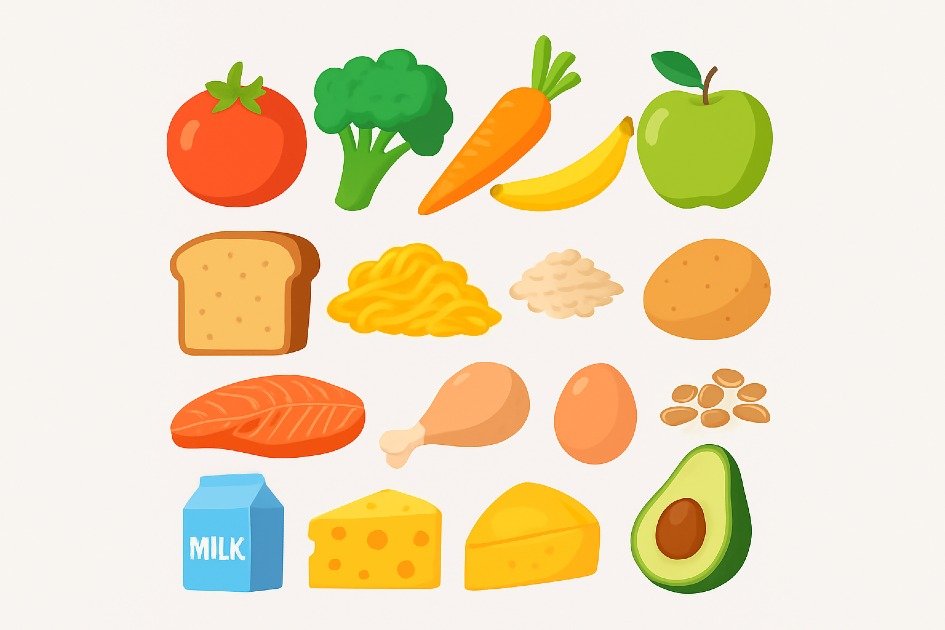Have you ever wondered why some people feel energized all day while others struggle after meals? The secret often lies in the building blocks of a balanced diet.
A balanced diet, combining proteins, carbohydrates, fats, vitamins, minerals, and hydration, supports long-term wellness by fueling the body, sharpening the mind, and enhancing mental health.
Harvard Health recommends a balanced diet with macronutrients and micronutrients such as fruits, vegetables, whole grains, legumes, nuts, seeds, and healthy fats for optimal health.
This article teaches how proteins, carbohydrates, healthy fats, and colorful fruits and vegetables provide essential vitamins and fiber. Proper hydration and portion control are crucial for maintaining health.
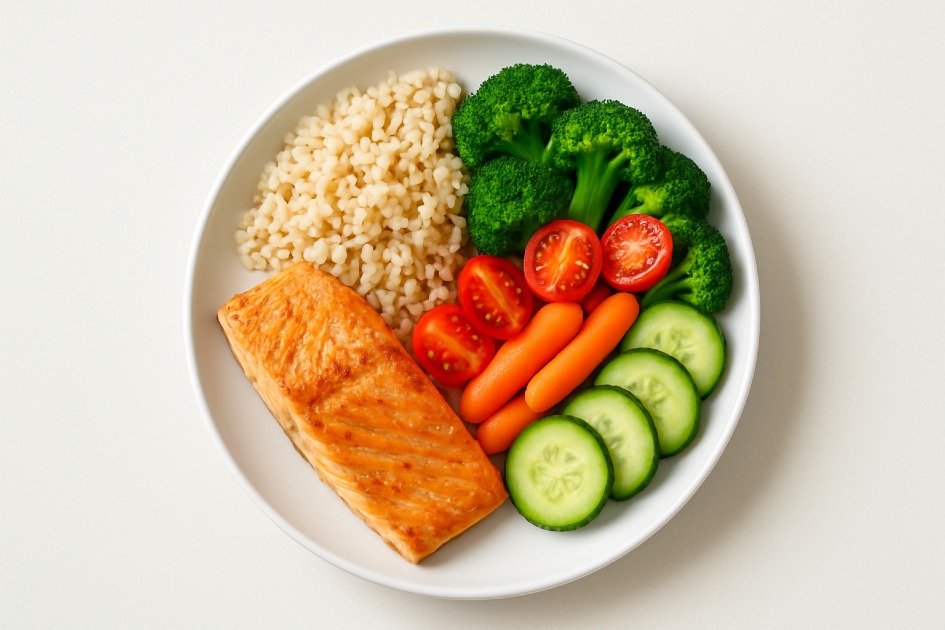
Understanding the Basics of a Balanced Diet
A balanced diet focuses on nourishment rather than calorie restriction, aiming to provide the body with the right mix of nutrients for daily thriving.
Balanced Diet Explained Simply for Better Health
Calorie counting is often viewed as the key to health, but this overlooks the quality of food, as processed snacks are different from whole, nutrient-rich foods.
A balanced diet, combining proteins, carbohydrates, healthy fats, vitamins, and minerals, is crucial for maintaining body function and harmony, rather than focusing on numbers.
When I stopped counting calories and started eating real foods like brown rice, leafy greens, and lean proteins, I felt more energized, my cravings faded, and my mood lifted.
Fuel Your Body with Proteins, Carbs, and Fats
Macronutrients, including proteins, carbohydrates, and fats, are essential nutrients for maintaining health and energy. Understanding their functions aids in creating a balanced diet for strength and activity.
Protein Repairs Your Body Fast
Underestimating protein is a major diet mistake, as it is crucial for muscle recovery and muscle loss, as it aids in rebuilding tissues and hormones.
Spread protein intake throughout the day by including eggs at breakfast, beans at lunch, or a protein-rich smoothie, and a clean protein powder if meals are lacking.
When I began adding a bit of protein to every meal, I noticed I had more energy and felt stronger all day.
Fuel Your Body with Carbohydrates
Modern diet culture often misrepresents carbs, but the issue lies in the type of carbs consumed, particularly refined carbs like white bread or sugary drinks.
To maintain a healthy weight, opt for complex carbohydrates like whole grains, quinoa, oats, and vegetables, which provide steady energy, stabilize blood sugar, and keep you full longer.
Switching my morning pastry for oatmeal with berries changed everything. I stopped feeling tired by midmorning and stayed focused and full of energy all day.
Healthy Fats Power Your Body
Fat has long been viewed as a threat, but eliminating it can disrupt hormones, brain function, and vitamin absorption, as not all fats are equal.
Prioritize healthy fats like avocados, nuts, olive oil, and fatty fish for heart health and satiety. Add chia seeds to yogurt for long-lasting nutrient benefits.
Fuel Your Day with Essential Vitamins and Minerals
Micronutrients are often overlooked in diets, leading to calorie-balanced meals but still lacking vitamins and minerals, potentially causing symptoms like fatigue or illness.
Eating the rainbow, as assorted colors in fruits and vegetables represent different nutrients, such as beta-carotene for eye health and iron and magnesium for energy.
I used to eat the same meal every day—chicken, rice, and broccoli. I thought I was being healthy, but I always felt tired. When I started adding more colorful fruits and veggies, my energy came back and I felt alive again.
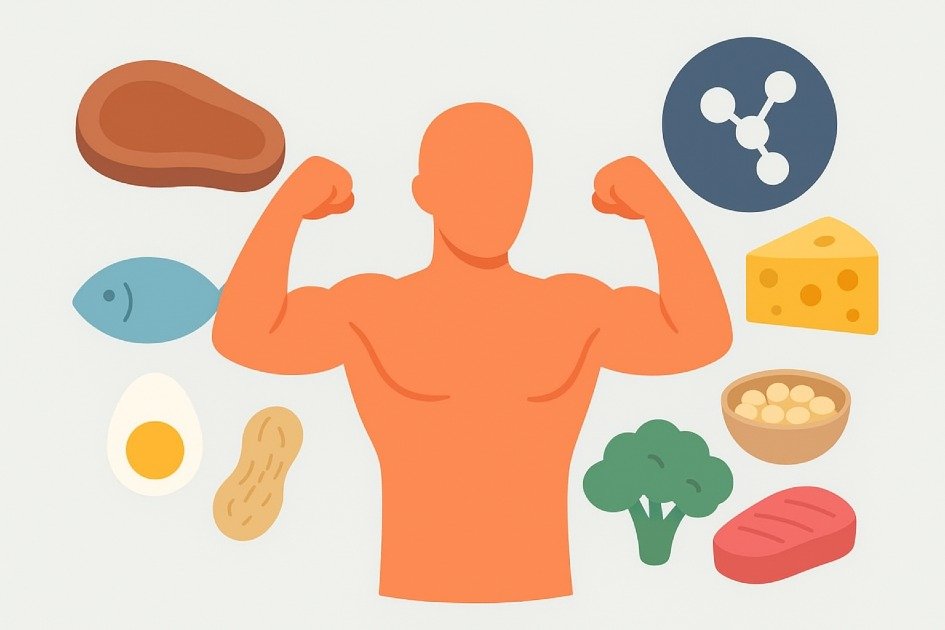
Protein Builds and Strengthens Your Body
Proteins are essential for muscle repair, immune system strength, and energy stability. Insufficient protein intake can lead to fatigue, muscle loss, and focus issues. Small, smart changes can address these needs.
Animals or Plant Proteins Which Works Best
Why it matters:
Animal proteins contain essential amino acids, but relying solely on them can increase cholesterol and limit diet variety, while plant proteins promote heart health, improve digestion, and provide fiber.
How to do it:
- Enjoy eggs in the morning and lentils at night for a balanced, protein-rich diet.
- Mix beans, tofu, or quinoa with meat to create a balanced and healthier meal.
- Vegetarians can get full protein by eating rice and beans together.
- Grab protein snacks like Greek yogurt or roasted chickpeas for a quick energy boost.
Finding Your True Protein Needs
Why it matters:
A sustainable diet requires a balance between protein intake and intake, as too much can hinder recovery, weaken muscles, and strain kidneys.
How to do it:
- Eat about 0.8 to 1.2 grams of protein for every kilogram you weigh to keep your muscles strong and your body healthy.
- Spread protein through your meals to keep your energy strong all day.
- Eat protein at breakfast to stay full longer and avoid cravings later in the day.
- Use apps or meal logs to stay on track and stop guessing what you eat.
Creative Ways to Include Protein in Every Meal
Why it matters:
Repetition can make your diet monotonous and discourage consistency. Creating fun ways to add protein keeps meals exciting.
How to do it:
- Choose oatmeal with almond butter instead of sugary cereal for a healthier, longer-lasting energy boost.
- Boost your salad with grilled chicken, beans, or nuts for extra protein and energy.
- Add protein powder to your smoothie for a fast, healthy energy boost.
- Swap cream cheese for cottage cheese to make your spread healthier and packed with protein.
Staying Full Longer with Protein
Why it matters:
Nonstop snacking may indicate a lack of protein in your diet, which stabilizes blood sugar and helps you feel full longer.
How to do it:
- Begin meals with protein foods such as eggs or lean meats to stay full longer and support strong muscles.
- Keep protein snacks like cheese sticks or bars with you to stay energized and curb hunger between meals.
- Keep protein snacks like cheese sticks or bars with you to stay energized and curb hunger between meals.
- Boost meals with protein by adding grilled salmon to pasta.
Balancing Protein with the Rest of Your Diet
Why it matters:
A balanced diet should include fats, carbohydrates, fruits, and vegetables for energy and micronutrients, as overloading on protein may hinder these essentials.
How to do it:
- Make a balanced meal with veggies, plus lean protein and whole grains to fuel your body every day.
- Use olive oil or avocado to boost your meals with healthy fats.
- Switch up your protein each week to keep your meals healthy and balanced.
I added eggs and protein powder to my meals and noticed I could focus better, control my cravings, and make smarter food choices. It boosted my work, workouts, and sleep.
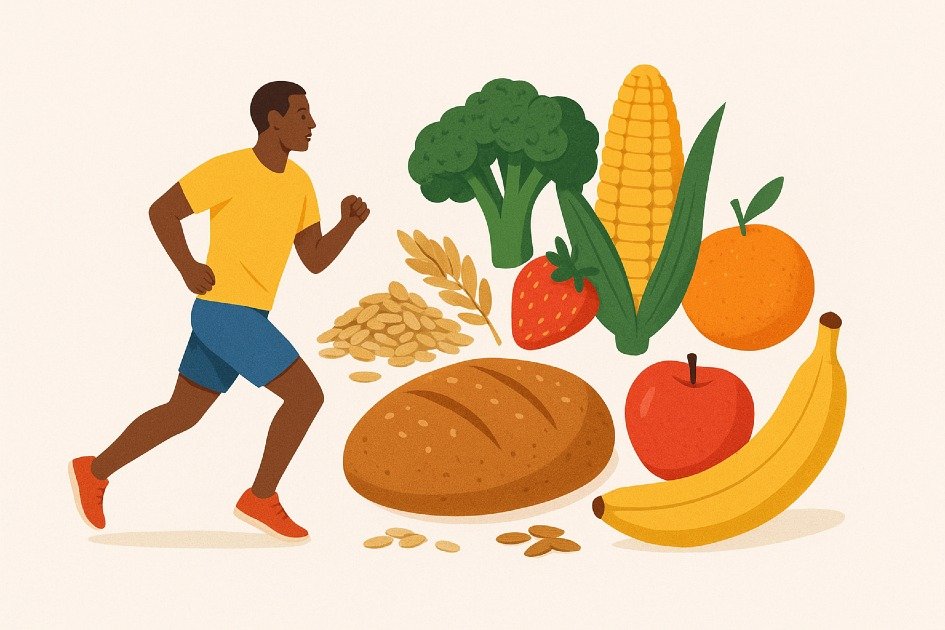
Power Your Day with Smart Carbs
Carbs, often criticized for their negative impact on weight loss, are essential for a balanced diet and the body’s primary fuel source. Making wise choices about carbohydrates can help maintain energy, nourishment, and health control.
Choose Carbs That Boost Health
Why it matters:
Processed carbs cause spikes in blood sugar, while whole carbs like brown rice, oats, and sweet potatoes digest slowly, providing steady energy and longer fullness.
How to do it:
- Choose whole grain bread instead of white bread to boost your fiber intake and support better digestion.
- Swap sugary treats for fresh fruit to enjoy a natural, healthy sweetness.
- Opt for baked sweet potatoes instead of fries to fuel your body with steady energy.
- Stock your pantry with healthy foods like oats and quinoa for easy, nutritious meals.
The Power of Whole Grains and Fiber-Rich Foods
Why it matters:
Whole grains are a rich source of fiber, which aids digestion, supports gut health, and reduces sugar absorption, thus reducing the risk of heart disease and promoting long-term wellness.
How to do it:
- Begin your day with oatmeal for a healthy boost and skip sugary cereals.
- Try new grains such as quinoa, bulgur, and farro to add nutrition and variety to your meals.
- Combine whole grain pasta with lean protein to create a healthy, balanced meal that fuels your body and supports long-term energy.
- Boost your meals with beans and lentils by mixing them into soups, salads, or rice for more fiber and nutrition.
Balancing Carb Intake for Steady Energy
Why it matters:
Maintaining a balanced diet involves portion control, pairing carbohydrates with protein and healthy fats, and avoiding excessive carb consumption to maintain steady energy throughout the day.
How to do it:
- Fill half your plate with vegetables, one-quarter with lean protein, and one-quarter with whole grains for a simple, balanced meal that fuels your body and keeps you healthy.
- Swap a large bowl of pasta for a smaller serving with chicken and sautéed vegetables for a healthy, balanced meal.
- Choose an apple with nut butter over plain crackers for a healthier snack.
- Eat carbs in lesser amounts throughout the day to keep your energy steady and avoid sudden crashes.
Simple Daily Habits to Improve Your Carb Choices
Why it matters:
Maintaining a diet based on small daily habits is easier than extreme changes, as simple swaps fuel the body while enjoying favorite foods over time.
How to do it:
- Carry fruit and nuts in your bag to skip processed snacks and fuel your body with natural energy.
- Prepare healthy carbs in large batches, such as brown rice or roasted veggies, so you always have nutritious options ready.
- Add a new whole-food carbohydrate to your meals each week to make your diet fun and healthy.
At first, cutting out carbs left me feeling tired. Then I added healthy carbs like oatmeal and quinoa, which gave me steady energy and made my meals healthier and more satisfying.
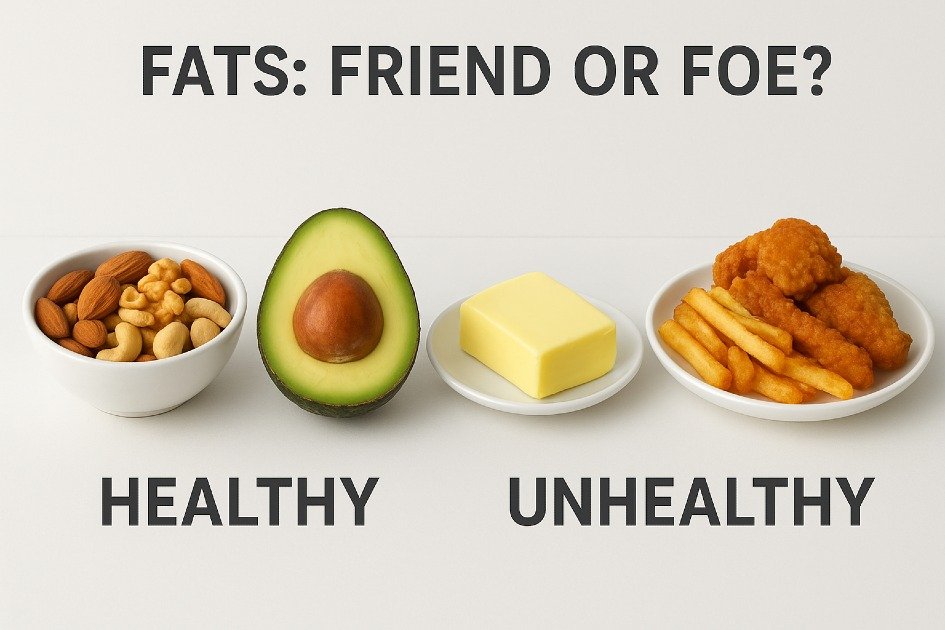
Fats Can Boost or Harm Health
Fat has long been a negative factor in healthy diets, but not all fats are equally harmful. It is crucial to understand which fats are essential for body function, energy, and mood.
Understanding Healthy Fats vs. Unhealthy Fats
Why it matters:
Unhealthy fats, like trans and saturated fats, can clog arteries and increase health risks, while healthy fats improve brain function and heart health.
How to do it:
- Use olive, avocado, or coconut oil instead of margarine or shortening for healthier cooking and better heart health.
- Choose nuts, seeds, or roasted chickpeas instead of fried snacks for a healthier, crunchy option.
I keep my heart strong, and my meals balanced by making this small, simple change.
Omega-3 and Omega-6 Boost Health and Vitality
Why it matters:
Omega-3 and omega-6 fats are crucial for brain health, fighting inflammation, and energy boost, but imbalances can lead to chronic issues.
How to do it:
- Eat fatty fish such as salmon, sardines, or mackerel several times a week to boost heart and brain health.
- Add flaxseeds or chia seeds to your smoothies or oatmeal for a quick boost of fiber, protein, and healthy omega-3 fats.
- Choose top-quality fish oil or algae supplements for better health.
When I balance these healthy fats, I feel less inflammation and more lasting energy every day.
Benefits of Heart-Healthy Fats to Daily Meals
Why it matters:
Healthy fats enhance cholesterol levels, lower cardiovascular disease risk, and maintain fullness, facilitating sustainable diets without feeling deprived.
How to do it:
- Add avocado to your toast or mix it into your salad for a fresh, healthy boost.
- Use a little extra virgin olive oil when cooking instead of butter.
- Choose almonds, walnuts, or pistachios for a smart snack instead of chips.
I love choosing nut butter made without added sugar or oils. They taste natural, keep me full longer, and give my body real, clean energy.
Fat Alone Does Not Make You Gain Weight
Why it matters:
People often mistake fat for body fat, but it is about calorie balance and food quality. The right fats support metabolism and aid weight management.
How to do it:
- Enjoy full-fat Greek yogurt and natural cheese in lesser amounts.
- Combine healthy fats and protein for steady energy—for example, try apple slices with almond butter.
I stopped fearing fat and found a way of eating that feels satisfying and easy to stick with.
Simple Swaps for Everyday Cooking
Why it matters:
Cooking habits significantly influence your diet, and making small kitchen adjustments can improve your diet without requiring a complete lifestyle overhaul.
How to do it:
- Swap butter for olive oil when cooking vegetables to make meals healthier and heart-friendly.
- Cook food by baking or grilling rather than frying to keep it healthier and lower in fat.
- Use nut oils such as walnut or macadamia to make your salads healthier and tastier.
I swap ingredients to keep meals tasty while lowering harmful fats.
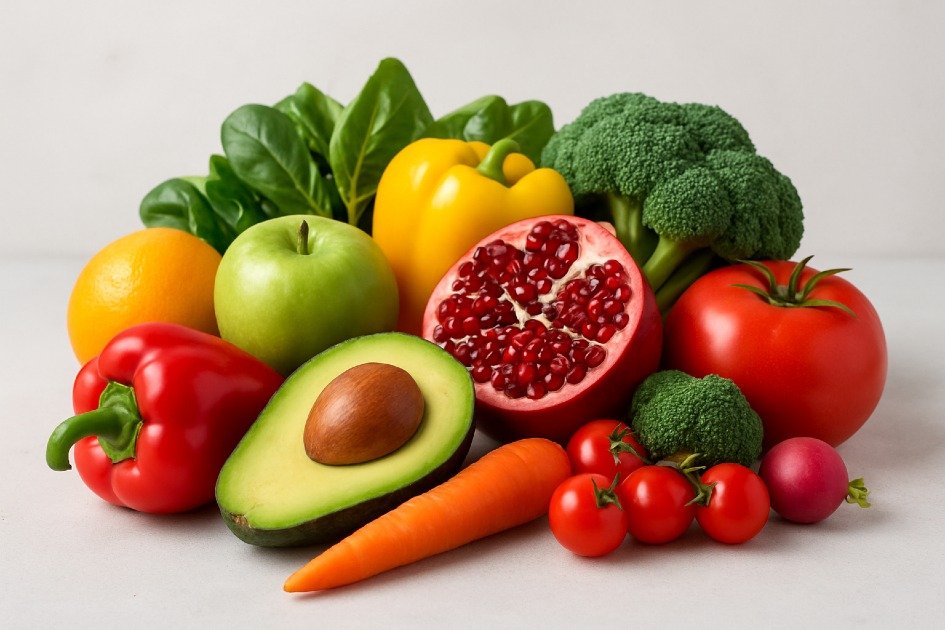
Boost Your Health with Fruits and Vegetables
Fruits and vegetables are essential for a healthier diet, but many struggle to consume them daily. Practical changes can help you increase your intake without feeling restricted.
Eat a Rainbow for Health and Energy
Why it matters:
A rainbow diet offers a variety of nutrients, including antioxidants, ensuring a visually appealing and nutritionally complete meal.
How to do it
- Mix three colors on your plate. Try green spinach, yellow peppers, and purple cabbage for a bright, healthy meal.
- Change your fruits and vegetables each week to keep meals fun and full of nutrients.
- Mix bright fruits into smoothies or add veggies to wraps for a tasty, healthy twist.
Eat Seasonal Local Foods for Peak Freshness
Why it matters:
Seasonal fruits and vegetables are harvested at peak ripeness, providing better flavor and higher nutrient density. Supporting local farms benefits the community and reduces costs.
How to do it
- Shop at your local farmers’ market for fresh, budget-friendly produce.
- Try a new seasonal vegetable every month to make your meals fresh and healthy.
Simple Strategies to Hit Your Daily Veggie Goal
Why it matters:
Adults often underestimate vegetables’ importance, lacking essential fiber, vitamins, and minerals, regulating blood sugar levels, and reducing long-term risks of heart disease, obesity, and type 2 diabetes.
How to do it
- Add veggies to everyday meals by mixing spinach in omelets, blending zucchini into sauces, or baking carrots in muffins for a healthy boost.
- Store ready-to-eat veggies in your fridge for fast, healthy snacks anytime.
- Begin your dinner with a small salad to get your body ready for healthy, nutrient-rich foods.
Balancing Fruits Without Overdoing Sugar
Why it matters:
Fruits are rich in natural sugars, fiber, and water, but overeating can disrupt a balanced diet. Moderation and selecting appropriate fruits support satiety.
How to do it
- Choose whole fruit over juice because juice loses the fiber your body needs.
- Eat fruit with protein or healthy fat like apple slices and peanut butter to keep your energy steady.
- Choose low-sugar fruits such as berries, apples, and pears instead of sweet ones like grapes or pineapples.
Making a Lifestyle, not a Chore
Why it matters:
A balanced diet prioritizes long-term sustainability, transforming fruits and vegetables into enjoyable habits for lifelong health benefits.
How to do it
- Get the whole family to help with cooking since kids eat more veggies when they help make them.
- Try using spiralizers or air fryers to make veggies fun, tasty, and easy to enjoy.
At first, I had trouble staying consistent, but adding broccoli to my meals and blending spinach into smoothies boosted my energy and made my skin glow while helping me cut down on processed foods.
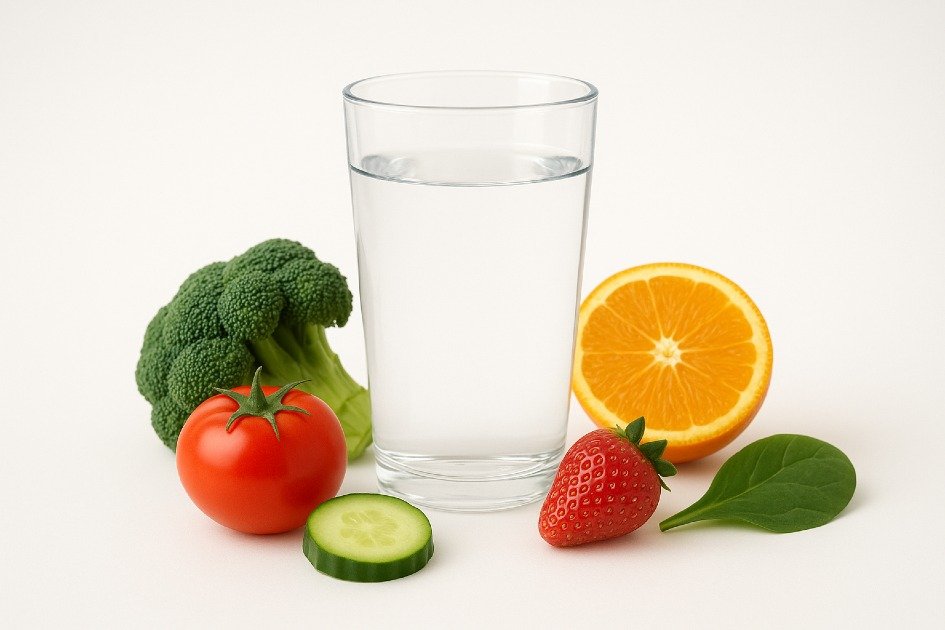
Stay Fully Hydrated for Health and Energy
Hydration is crucial for digestion, skin hydration, focus, and body temperature regulation, often overlooked in diet improvement efforts, despite being essential for overall health.
How Much Water Do You Really Need?
Why it matters:
The body, comprising 60% water, relies on it for all cells, tissues, and organs, and even slight dehydration can lead to fatigue, headaches, and poor concentration.
How to do it:
- Drink 8 to 10 cups of water each day and have more if you exercise or live somewhere hot.
- Carry a reuseable water bottle to remind yourself to drink water often and stay hydrated all day.
- Use a hydration app or write in a small journal to keep track of how much water you drink each day.
Hydrating Foods That Count Too
Why it matters:
Some foods hydrate you just like water while giving extra nutrients that boost your health naturally.
How to do it:
- Eat more fruit and vegetables with lots of water, such as cucumbers, watermelon, oranges, and celery, to stay fresh and hydrated naturally.
- Begin your meal with a small salad to stay hydrated and feel full faster.
- Blend fruits and vegetables into smoothies for a tasty way to stay hydrated and boost your fiber naturally.
I use a high-speed blender to make quick, refreshing smoothies that keep me hydrated all day.
The Hidden Dangers of Dehydration
Why it matters:
Dehydration, often overlooked, can cause mild symptoms like dizziness or irritability, hinder digestion, slow metabolism, and sabotage diet goals in the long term.
How to do it:
- Look out for signs like a dry mouth, dark urine, or feeling extra tired — they may mean your body needs more water.
- Stay hydrated by drinking water or electrolyte drinks after exercise or on hot days to keep your body strong and energized.
- Cut back on alcohol and sugary sodas to keep your body hydrated and healthy.
Timing Your Hydration for Better Health
Why it matters:
Proper timing is crucial for digestion and nutrient absorption from your diet, not just focusing on the amount you consume.
How to do it:
- Start your day by drinking a glass of water.
- Drink water before meals to help your body digest food better and stop you from eating too much.
- Drink water right after your workout to replace lost fluids and keep your body strong.
Small Habits That Make Hydration Stick
Why it matters:
Small daily habits make staying hydrated easy and help your diet stay healthy for life.
How to do it:
- Try adding lemon, mint, or berries to your water for a tasty, healthy twist.
- Drink water every hour, especially when sitting at a desk, to stay energized and focused.
- Keep water by your bed to stay hydrated first thing in the morning and before sleep.
I use a smart tracker that keeps an eye on my water intake and nudges me to drink enough every day.
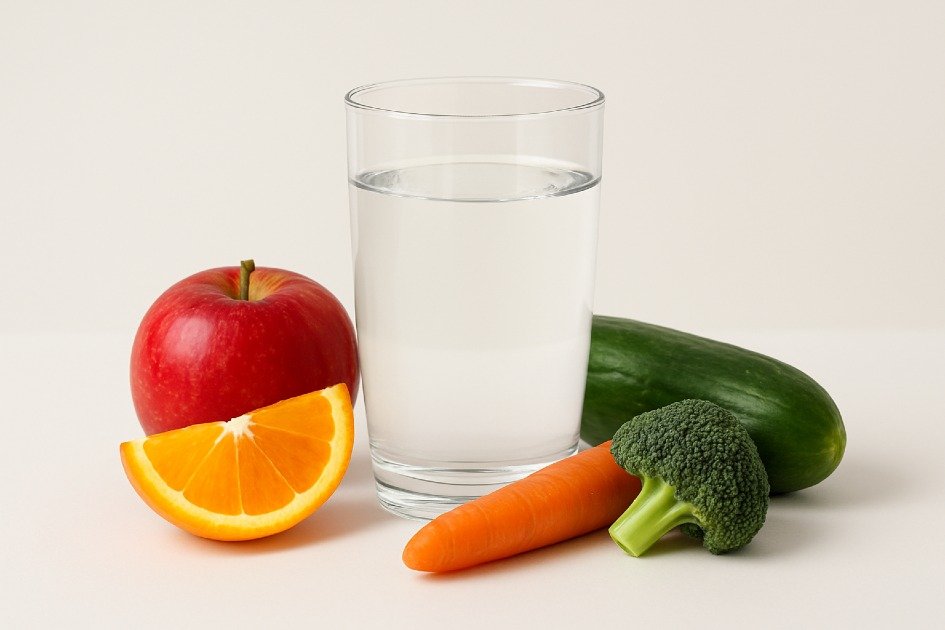
Mindful Eating to Enjoy Every Bite
Eating well involves mastering portion control, allowing you to enjoy favorite foods while maintaining body hydration and balance.
Master Serving Sizes Without Tracking Calories
Why it matters:
Overestimating food intake can hinder weight management and energy, so it is crucial to learn proper serving sizes to maintain a healthy diet without overemphasizing calorie calculations.
How to do it:
- Use your hand to measure meals. Fill your palm with protein, your fist with carbs, and your thumb with healthy fats.
- Use smaller plates to help control how much you eat and prevent overeating naturally.
- Serve snacks in small bowls instead of eating directly from the bag to help control portions and prevent overeating.
- Use measuring cups for a week to train your eyes to see the right portion sizes.
Build Balanced Meals with the Plate Method
Why it matters:
The plate method promotes balance in a healthy diet by avoiding overthinking and ensuring that one food group does not dominate the others.
How to do it:
- Eat a variety of colorful vegetables on half your plate to boost vitamins and fiber.
- Fill one-quarter of your plate with lean protein such as chicken, fish, or beans.
- Fill one-quarter of your plate with whole grains or starchy vegetables for steady energy and better digestion.
- Include a bit of healthy fat such as avocado or olive oil in your meals for better heart and brain health.
Steps to Avoid Overeating Without Feeling Deprived
Why it matters:
Smart strategies can help maintain a balanced diet by allowing full enjoyment of meals while reducing guilt and sluggishness often associated with overeating.
How to do it:
- Eat slowly; give your stomach time to signal fullness.
- Put utensils down between bites.
- Chew your food slowly and pause between bites so your stomach can tell you when you are full.
- Begin meals with a light soup or fresh salad to curb hunger and eat less overall.
Savor Every Bite with Awareness
Why it matters:
Smart strategies can help maintain a balanced diet by allowing full enjoyment of meals while reducing guilt and sluggishness often associated with overeating.
How to do it:
- Focus on your meal and put away your phone or TV to eat mindfully and enjoy every bite.
- Notice the way foods feel, smell, and taste.
- Pause to feel grateful before eating. It helps you eat slower and enjoy your food more.
- Pause midway and notice how hungry you still feel. Adjust your eating to match your body’s signals.
Powerful Snacks That Boost Health
Why it matters:
Snacking can disrupt a balanced diet when choices are random or portions are uncontrolled. Planned, nutrient-dense snacks maintain energy and prevent overeating.
How to do it:
- Combine protein with fiber by spreading peanut butter on apple slices for a healthy, filling snack.
- Pack snacks into small containers to stop eating without thinking.
- Keep snacks like nuts, yogurt, and hummus within reach to make healthy choices easy.
- Enjoy treats only at set times instead of snacking all day.
Portion Control When Eating Out
Why it matters:
Restaurants often serve larger portions than necessary, which can quickly disrupt a healthy diet without proper strategy.
How to do it:
- Order smaller portions or split meals with others to eat just the right amount and reduce food waste.
- Order dressings and sauces separately to control how much you use and keep your meal healthier.
- Chew your food slowly and listen to your body.
I always bring my leftovers home to enjoy another meal. It saves money, reduces waste, and gives me an easy, healthy option later.
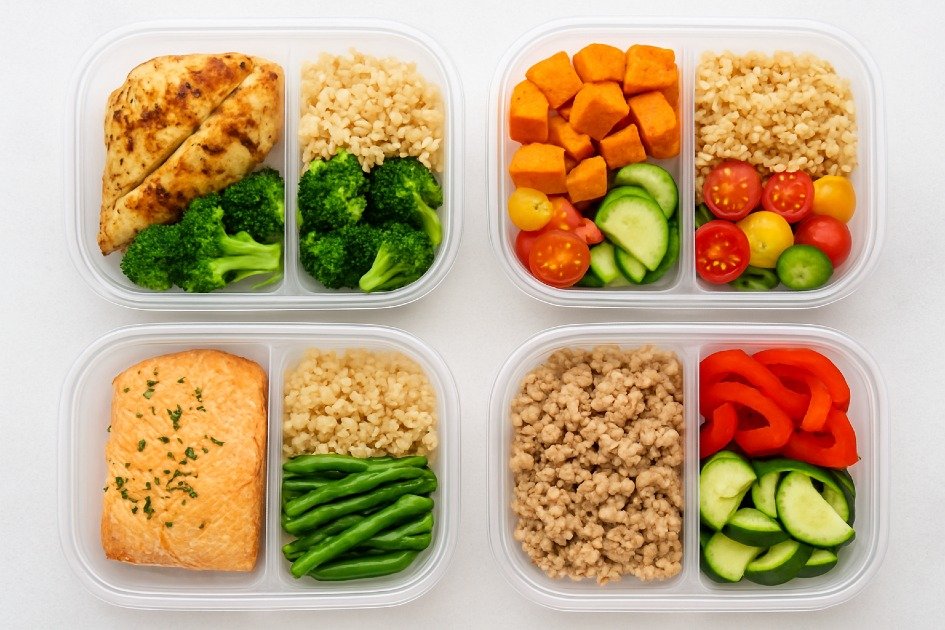
Eat Balanced by Planning Meals Wisely
Slight changes in meal planning and preparation can significantly improve a balanced diet, especially for busy individuals struggling with cravings or grocery shopping.
Creating a Weekly Meal Blueprint That Works
Why it matters:
A weekly plan aids in maintaining a healthy diet, saving time, money, and reducing food waste, while also ensuring adequate protein, fiber, and colorful vegetables.
How to do it:
- Savor each bite and pause when you feel full, not stuffed.
- Pick two or three simple recipes your family enjoys and make them often.
- Try a new recipe each week to keep meals fun and healthy.
- Switch up your meals to keep taste exciting while cooking easy.
Fast and Nutritious Meal Prep Tips
Why it matters:
Preparing meals in advance helps prevent last-minute fast-food choices, reduces daily stress, and supports portion control and consistency in your diet.
How to do it:
- Cook proteins like chicken, beans, or tofu in large batches so you can quickly add them to meals all week.
- Prep vegetables early and keep them in clear containers so you can grab healthy snacks or meals quickly.
- Make quick breakfasts by prepping overnight oats or smoothie packs.
I keep my meals organized by using portioned containers from a trusted kitchenware brand. They make storing food easy and help me control servings without any hassle.
Balancing Meals Throughout the Day
Why it matters:
Balancing meals helps maintain a healthy diet, stabilizes blood sugar, prevents cravings, and maintains focus and productivity.
How to do it:
- Fill half your plate with vegetables, a quarter with protein, and a quarter with carbs for balanced, healthy meals.
- Combine lean proteins with complex carbs to keep your energy steady all day.
- Boost fullness by eating healthy fats such as avocado or olive oil.
- Eat at regular intervals and avoid going more than 4–5 hours without food to keep your energy steady and your body fueled.
Making Room for Flexibility in Your Diet
Why it matters:
A flexible diet promotes long-term sustainability and balance, preventing burnout and guilt caused by slipping up, highlighting the importance of balance in a healthy diet.
How to do it:
- Enjoy treats like pizza or dessert once or twice a week to keep your diet balanced and satisfying.
- Follow the 80/20 rule by filling most of your meals with healthy foods and saving a small part for treats.
- Focus on portion control to enjoy all foods without banning anything.
I swap smarter choices into my meals, like whole-grain pasta for regular pasta and dark chocolate for candy, to enjoy treats without losing health.
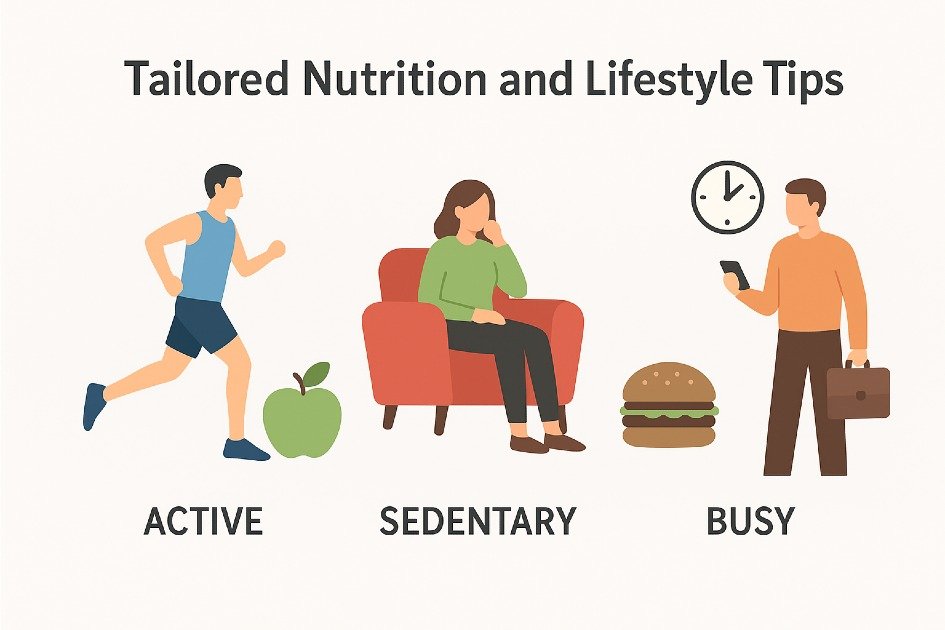
Special Considerations for Different Lifestyles
Lifestyle, age, and activity levels significantly influence a balanced diet, and it is crucial to understand how these factors can impact your overall health.
Balanced Diet for Busy Professionals
Why it matters:
Rushing lifestyles often result in skipped meals or fast food, which can negatively impact focus, productivity, and immunity.
How to do it:
- Pack easy meals you can take anywhere such as overnight oats, protein bars, or sliced fruits for quick, healthy snacking.
- Cook in batches once a week by making staples like grilled chicken, quinoa, and roasted vegetables. Store them in containers to quickly build healthy meals anytime.
- Try smart snacking by choosing almonds, Greek yogurt, or hummus with carrot sticks instead of chips.
- Keep a refillable water bottle at your desk and drink regularly throughout the day to stay healthy and energized.
Nutrition Adjustments for Active Individuals
Why it matters:
Exercise burns calories and depletes glycogen stores, leading to fatigue, injury, and slower recovery without proper nutrients.
How to do it:
- Focus on protein by eating lean meats, beans, or plant-based powders after exercise to help your muscles recover and grow stronger.
- Fuel up with whole-grain pasta, rice, or sweet potatoes before your workout to keep your energy steady and strong.
- Keep your electrolytes steady by eating bananas, drinking coconut water, or using electrolyte tablets to replace lost minerals.
- Refuel after workouts with carbs and protein to help muscles recover. Try chicken with brown rice or a banana whey smoothie.
Dietary Needs for Aging Adults
Why it matters:
As we age, muscle mass naturally decreases, bone density decreases, causing increased fracture risk, and digestive efficiency decreases, making certain vitamins harder to absorb.
How to do it:
- Eat protein at every meal to keep muscles strong with eggs, beans, fish, or lean meats.
- Get more calcium and vitamin D by eating yogurt, fortified cereals, or taking vitamin D supplements.
- Eat fiber every day by choosing whole grains, lentils, and leafy greens to keep digestion smooth and prevent constipation.
- Eat small meals often to keep energy steady and cover all your nutrients.
Diet for Remote Workers
Why it matters:
Constant snacking leads to excess calories, while sedentary routines help lower calorie needs, making balance essential.
How to do it:
- Follow a regular breakfast, lunch, and dinner routine to prevent snacking without thinking.
- Prepare fruits, nuts, and eggs ahead to have healthy snacks ready anytime.
- Keep your workspace tidy and store snacks out of sight to curb cravings and stay focused.
- Take short walks or stretch between meetings to keep your metabolism active and energy high throughout the day.
Dietary Shifts for Students
Why it matters:
Nutrient deficiency negatively impacts memory, focus, and academic performance, while cheap fast-food habits can lead to long-term health issues.
How to do it:
- Stock up oats, beans, frozen veggies, and eggs to eat well without overspending.
- Try meals that mix complex carbs and protein like rice with lentils to stay focused and energized all day.
- Switch sugary energy drinks for green tea or black coffee to boost energy the healthy way.
I cook in bulk, so I do not have to rely on instant noodles every night. Having ready meals keeps me healthy, saves time, and makes it easier to stick to good eating habits.
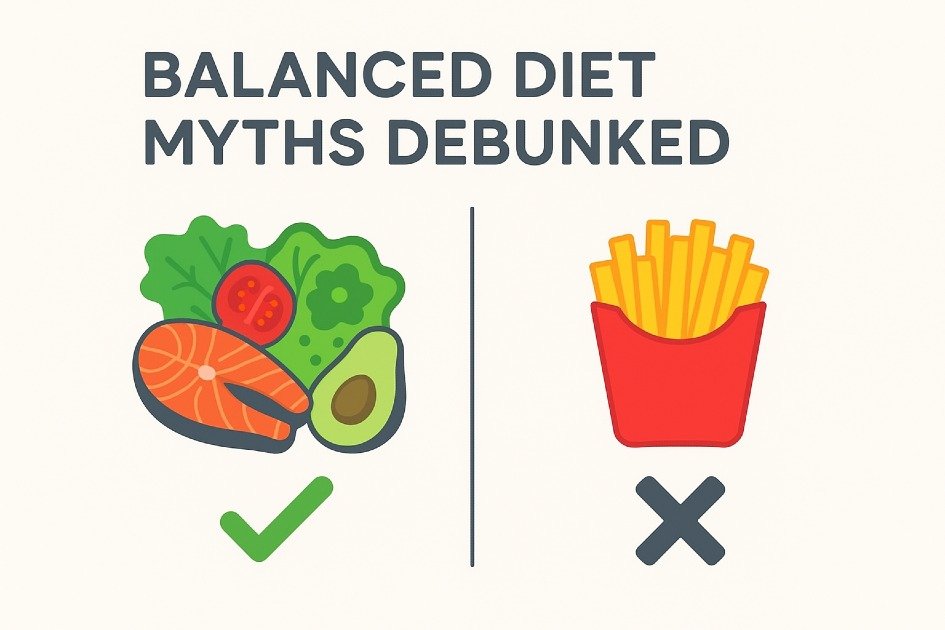
Busting Popular Myths About Balanced Diets
Diet myths often confuse people about a balanced diet, which is about smart, sustainable choices that fuel the body and fit your lifestyle, not deprivation or complicated rules.
“Carbs Make You Fat”
Why it matters:
Carbs, including whole grains like oats, brown rice, and sweet potatoes, provide glucose and fiber, aiding digestion and maintaining fullness, but their demonization can lead to unhealthy, restrictive diets.
How to do it:
- Pick complex carbs like quinoa, beans, and whole wheat bread to fuel your body with lasting energy and keep your blood sugar steady.
- Cut back on foods like white bread, pastries, and sugary cereals.
- Fill half your plate with colorful vegetables, one-quarter with lean protein, and one-quarter with whole grains.
“Fat Is Always Bad”
Why it matters:
Healthy fats lower inflammation and protect heart health, while low-fat diets can lead to hunger and unsatisfaction. Certain vitamins require fat for absorption.
How to do it:
- Try adding avocado slices to your salads and sandwiches.
- Use olive or avocado oil for cooking instead of margarine to boost heart health and add natural, healthy fats to your meals.
- Choose nuts, seeds, or salmon for a healthy snack that boosts heart and brain health.
“You Need Supplements for a Balanced Diet”
Why it matters:
Supplements can mask poor eating habits due to fillers and low-quality ingredients, while food provides a synergy of nutrients that supplements cannot replicate.
How to do it:
- Prioritize whole food by filling your plate with colorful vegetables, fruits, lean proteins, and whole grains for better health.
- Check your levels before taking supplements like vitamin D or iron to stay safe and healthy.
- Take supplements only to cover what your diet misses and not as a full replacement.
“Enjoy Foods Without Sacrificing Health”
Why it matters:
Strict rules can lead to guilt and shame, hindering sustainable diets. Allowing small indulgences and enjoying food can help maintain long-term health and satisfaction.
How to do it:
- Practice the 80/20 rule: eat nutritious foods 80% of the time, leave 20% for flexibility.
- Split desserts with someone or choose smaller servings to enjoy sweets without overdoing it.
- Enjoy each bite of your favorite food slowly so your body feels full and you eat just the right amount.
“Fad Diets Are the Fastest Way to Get Results”
Why it matters:
Extreme restrictions can strain the body and metabolism, while yo-yo dieting can damage confidence. Balanced, steady changes lead to long-term success.
How to do it:
- Choose meal routines you enjoy and can keep up with.
I choose slight changes every day, like drinking water instead of soda, to keep my body healthier and my energy steady.
Recap: Building Lifelong Healthy Eating Habits
A balanced diet is about nourishment, not restriction. It is a flexible framework that adapts to your lifestyle, focusing on consistency rather than perfection.
Harvard Health suggests a healthy eating plan, focusing on natural, unprocessed foods, plant-based foods, protein, low sugar and salt, and healthy fats like fish and olive oil, to establish lifelong healthy habits.
By choosing nutrient-dense foods, prioritizing hydration, and practicing mindful portioning, you can create a lifelong partnership between your body and food.
A balanced diet evolves with you, allowing you to enjoy meals guilt-free while achieving wellness goals. Practical tools like meal planning apps and nutrient trackers can help.
Remember, your diet is not a punishment but a foundation for a vibrant life, shaping your mood, productivity, and aging. Start small with slight changes, like adding vegetables or drinking more water.
Frequently Asked Questions
How can I balance my diet without giving up my favorite foods?
A balanced diet promotes inclusion rather than exclusion, allowing for mindful moderation. Pair indulgent meals with nutrient-dense options for a satisfying experience. Use portion-control tools or meal guides like healthy plate sets for visual aids.
Can I skip supplements if I eat healthy every day?
Modern lifestyles often lead to deficiencies in essential nutrients like vitamin D, omega-3 fatty acids, and magnesium, despite a rich diet. Supplements can provide a safety net and enhance a well-balanced diet.
How do I adjust my diet for weight loss or gain safely?
To achieve weight loss, make small calorie reductions with high-satiety foods like legumes, nuts, and leafy greens, or gain with nutrient-dense foods like avocado, nut butters, and quinoa. Tailor your diet gradually, prioritizing consistency and enjoyment.
Can a vegetarian or vegan diet be fully balanced?
Yes, a plant-forward diet can provide all essential nutrients if it is strategically planned. Incorporating protein sources like lentils, chickpeas, tofu, and tempeh, can provide essential nutrients like iron, vitamin B12, and omega-3s.
How often should I reassess my diet for optimal health?
Diets adapt to lifestyle, age, and health status, requiring regular evaluations and adjustments every 6–12 months to accommodate lifestyle changes like pregnancy, increased activity, or aging.

